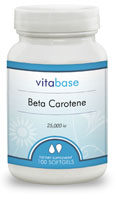| Vitamin A is essential for the functioning of the immune system. Vitamin A is required to enable the immune system to trigger the body's response to infections, and for achieving normal vision and reproductive health. Vitamin A maintains healthy cells in various structures of the eye and is required for converting light into nerve signals in the part of the eye called the retina. Vitamin A is stored in the liver and deficiency of the vitamin occurs only after prolonged lack of dietary intake. Vitamin A is found in meat and
dairy products, as well as fruits and vegetables. It is a fat-soluble substance that is divided into retinol and provitarnin A. Retinol is the active form of vitamin A usually found in animal products, while provitamin A is found in fruits and vegetables.
Vitamin A deficiency occurs with the chronic consumption of diets that are deficient in both vitamin A and beta-carotene. Beta-carotene is a form of pre-vitamin A, which is readily converted to vitamin A in the body. Beta-carotene is a very effective antioxidant and is suspected to reduce the risk of cancers known to be initiated by the production of free radicals. Of particular interest is the potential benefit of increased b-carotene intake to reduce the risk of lung cancer in smokers. For children, lack of vitamin A causes severe visual impairment and blindness, and significantly increases the risk of severe illness, and even death, from such common childhood infections as diarrhoeal disease and measles. For pregnant women in high-risk areas, vitamin A deficiency occurs especially during the last trimester when demand by both the unborn child and the mother is highest. The mother’s deficiency is demonstrated by the high prevalence of night blindness during this period. VAD may also be associated with elevated mother-to-child HIV transmission. According to the World Health Organization, between 100 and 140 million children worldwide are vitamin A deficient. An estimated 250 000 to 500 000 vitamin A-deficient children become blind every year, half of them dying within 12 months of losing their sight. Nearly 600 000 women die from childbirth-related causes each year, the vast majority of them from complications which could be reduced through better nutrition, including provision of vitamin A.
Vitamin A is an important nutrient to maintain eye health. Vitamin A is a constituent of retinal which is found in the rods of the retina of the eye combined with a protein called opsin to form visual purple (rhodopsin). When vitamin A is not available to the body, gradual changes begin to affect the eye. The first sign of a problem is when a child or a pregnant or lactating woman finds it difficult to adjust to seeing in the dark. This condition is called night blindness. In fact, vitamin A deficiency is the single greatest preventable cause of childhood blindness. People most at risk are children between six months to six years, pregnant women, and lactating women. Vitamin A deficiency is the leading cause of preventable blindness in children and raises the risk of disease and death from severe infections.
Breast milk is a natural source of vitamin A. Promoting breastfeeding is the best way to protect babies from VAD. For deficient children, the periodic supply of high-dose vitamin A in swift, simple, low-cost, high-benefit interventions has also produced remarkable results, reducing mortality by 23% overall and by up to 50% for acute measles sufferers. Food fortification, especially the fortification of widely consumed commercially processed food products (e.g. sugar, edible oil, cereal flours, milk) is a viable strategy to increase vitamin A consumption. It requires relatively little behavior change and minimal resource allocation. Supplementing children aged six months to five years with two high-dose vitamin A capsules a year has been identified as a safe, cost-effective, efficient strategy for ending vitamin A deficiency. Giving vitamin A to new mothers who are breastfeeding helps protect their children during the first months of life. Food fortification is also a central strategy that is being introduced in more and more countries and holds great hope for the future. | 